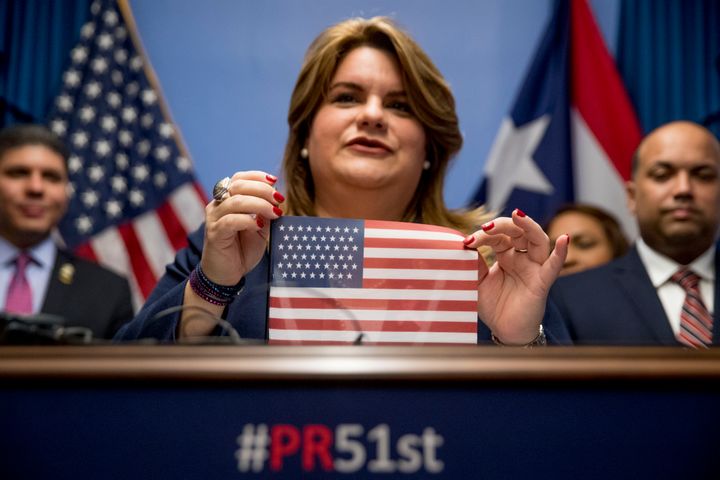U.S. Rep. Jenniffer González-Colón, Puerto Rico’s former nonvoting delegate to the U.S. Congress and an ally of Donald Trump, is leading in the island’s gubernatorial race, likely extending her pro-statehood party’s streak in control of the United States’ most populous unincorporated territory.
With nearly 40% of the vote in a five-way race, Puerto Rican election commissioners certified preliminary results on Tuesday night that declared her the winner.
“I am going to be the governor of all Puerto Ricans,” she said in a victory speech.
Her election offered Republicans another win the same night Trump secured his return to the White House and the GOP retook the Senate. While she is a member of Puerto Rico’s pro-statehood New Progressive Party, she is the first Republican elected governor in the territory since 2008.
González-Colón, 48, is expected to defeat a spirited challenge from Juan Dalmau, the first candidate from Puerto Rico’s long-marginalized Independence Party to come close to victory on a promise to break away from the U.S. He is currently trailing six points behind in second, more than 10 points ahead the third-place candidate from the traditional opposition party.
Since Puerto Ricans living in the territory cannot vote in the presidential election, party politics on the island revolve around the question of colonial status. For most of the 76 years since the U.S. began allowing Puerto Ricans to choose their own governors, elections have swung between the Popular Democratic Party, which pioneered the semi-autonomous “commonwealth” status as a way to quell demands for independence, and the New Progressive Party, which advocates for joining the U.S. as the 51st state.
As Puerto Rico’s economy spiraled over the past decade, the pro-statehood party maintained control of La Fortaleza, the historic Spanish governor’s mansion in Old San Juan. Gov. Ricardo Rosselló, a registered Democrat in his mainland U.S. party affiliation, held office from 2016 until his resignation three years later amid massive street protests over a corruption scandal. Puerto Rico’s Senate and judiciary appointed Republican Wanda Vázquez Garced to the job for the next two years. Pedro Pierluisi, a Democrat and former coal lobbyist, continued the New Progressive Party’s streak, winning the 2020 election.
But González-Colón defeated Pierluisi in the primary this year, outflanking her fellow statehood supporter by attacking the incumbent over ongoing blackouts and rising electricity bills since the government put a private company in charge of the grid three years ago. She would be the first woman elected governor of the island, the second to serve in the role.
It’s unclear what González-Colón, a supporter of efforts to privatize the power grid, would do to manage LUMA Energy, the island’s private utility, differently.
Years of New Progressive Party rule have done little to advance Puerto Rico’s prospects of statehood.
Nearly 60% of Puerto Rican voters cast ballots in favor of statehood in a nonbinding referendum similar to those held in 2012, 2017 and 2020. As in those other plebiscites, the statehood side won, but with a significant number of voters boycotting the ballot measure to discredit the results. As of Wednesday morning, over 16% of voters who cast ballots in the gubernatorial race skipped the plebiscite.
Congress would need to pass legislation to allow Puerto Rico to either become a state or declare independence. Though the Reagan-era Republican Party supported Puerto Rican statehood, the GOP has dismissed admitting Puerto Rico into the union as a ploy by Democrats to add two Latino senators both sides suggest would be shoo-in liberals, despite the island’s widespread social conservatism and González-Colón’s success.

Puerto Rico’s economic downturn began even before back-to-back hurricanes destroyed the island’s electrical infrastructure in 2017.
In 1996, the federal government started phasing out the manufacturing tax credit that buoyed the territory’s midcentury economic growth. As good-paying jobs disappeared, the Puerto Rican government hired more workers to public sector jobs. But as the industrial tax base dried up, the island relied on borrowing money by issuing bonds.
For years, Puerto Rico was considered the belle of the bond market ― a steady investment backed by the credit of the U.S. Treasury. By 2016, the debt ― money owed both to bondholders and pensioners who expected retirement payouts ― surpassed $125 billion.
Not an independent country, Puerto Rico could not go to international lenders for support. Not a fully incorporated part of the U.S. either, the territory could not access the same bankruptcy protections that benefit mainland American municipalities, such as Detroit.
Instead, employing an acronym that spelled the Spanish word for “promise,” Congress passed the PROMESA Act, establishing an all-powerful fiscal oversight board appointed by the White House with veto power over all the elected Puerto Rican government’s financial decisions.
The fiscal control board instituted brutal austerity cuts, closing hundreds of schools and slashing pensions in a territory with worse poverty than the poorest U.S. state.
After the Category 5 Hurricane Maria struck Puerto Rico on Sept. 16, 2017, it took 11 months to restore power to some parts of the island, marking the second-longest blackout in world history. While academics debate how many deaths to directly attribute to the storm and its aftermath, scholars generally agree that thousands more Puerto Ricans died after the floodwaters receded due to power failures that affected access to refrigerated medicine, clean water and breathing machines, among other needs.
Seven years later, the average Puerto Rican still suffers weekly if not daily blackouts. But now they pay bills to LUMA Energy, formed as a joint venture between two energy companies from Texas and Canada, rather than to the old state-owned utility. And the rates keep going up, even as service worsens.

